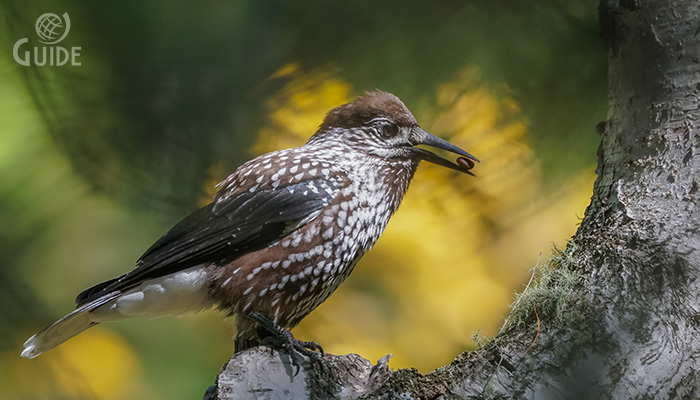
English: Spotted
Nutcracker, Eurasian Nutcracker
Russian: Кедровка, Ореховка
Mongolian: Бидэрт самарчшаазгай, Самарч шаазгай
German: Tannenhaher
French: Cassenoix
mouchete
Japanese: ホシガラス (Hoshi-garasu)
Body
length: 32-35 cm
Wing
swan: 49-53 cm
Breeds almost
exclusively in areas with easy access to spruce forests for nesting and rich
supply of either hazel or arolla pine for winter food stores. Nuts and seeds
are cached in the ground layer during late summer-autumn, and nut depots are
memorized in detail and can be re-found in winter with great accuracy, even
beneath thick snow cover. European breeders (ssp. caryocatactes), vigilant and
shy, are residents. In some years, when in Siberia the arolla pine’s seed crop
is poor, large flocks of the slender-billed race (macrorhynchos) of E Russia
and Siberia can move in early autumn all the way to W and C Europe, there
appearing both tame and bold; local breeding populations have then been
established in Fenno-Scandia and even in C Europe. Omnivorous in summer. Nests
in dense conifer close to trunk. Early breeder.
Identification: Size of a Jay but
with quite different proportions: tail is short (best feature in flight) and
bill long and powerful. Head is more elongate than Jay’s and lacks hint of
crest. Plumage is dark brown and sprinkled with small white spots; crown and
greater part of wings are, by contrast, unspotted brownish-black. Wings broad
and rounded. Flight direct, often high up, with fluttering, slightly hesitant
wingbeats recalling Jay. From below, shows contrastingly white vent and white
tail-tip. Sexes alike and ages similar.
Variation: In Europe, bill is heavier
(thicker base) and tail has narrower white tip. In Siberian race macrorhynchos,
bill is more uniformly narrow and average a trifle longer, and tail has broader
white tip.